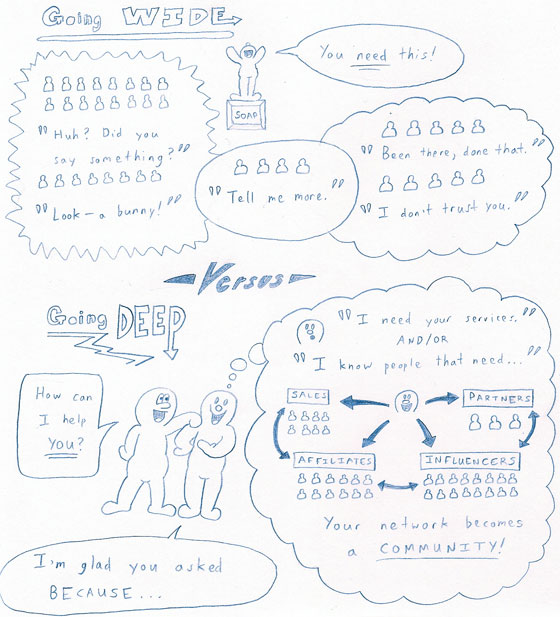Ever notice how so-called “SEOs” are usually at the butt end of jokes?
I reckon a good part of that may be that Search Engine Optimization providers have little or no marketing background so we tend to get stuck in the technical dribble (K.I.S.S. and make up, anyone?) of it all. On the flip side, quick-fix SEO techniques like cloaking, keyword stuffing, and autoblogging made it easy to cut corners and not do the stuff that takes continued effort.
The bigger issue with SEO douchebaggery, as some would have it called, may very well be short-sightedness. Some of us take for granted “what works today” but fail to prepare for the future. Of course, there are the bullshit artists, which seems to be common in B2B services as a whole, especially in the New Media space. But I digress… Don’t let a few bad apples you lead you to dismissing valuable business strategies like SEO.
With all that in mind, disregarding the value of SEO can truly hurt your business or sell you short – SEO is amazing for conversions!

Editors note: Make sure you read all the way down to see Yomar’s great Sketchographic (or, as he likes to call it, Infodoodle)
So where do our fellow SEOs go wrong?
I’ve spoken to self-proclaimed SEO experts (don’t get me started on the fallacy of expertise). They each have a different answer for what the ultimate goal of Search Engine Optimization really is.
These answers include, but are not limited to…
- Higher SERP ranking on Google
- Increased brand awareness (and protecting your brand)
- Greater organic traffic sources
- More leads to your web site
The last answer is a little closer yet it still falls short. You see, good SEO should tie into a real Internet marketing strategy, whether you call your approach “people marketing”, “mass amplification”, “social networking”, or whatever.
Why?
Because even the best content will get you nowhere if you are not bringing the right people to it. I strongly urge online-only and online-focused businesses to move away from the numbers game that we may be accustomed to. Focus more on engaging people and less on marketing. In short, share your message with people that are really listening and really care.
The hard lesson we online businesses learn at some point is this:
“All that extra traffic is nothing to you if you don’t do something with it.”
SIDEBAR: I believe Seth Godin’s book, All Marketer’s Are Liars, advises us against departmentalizing marketing and that’s exactly what I’m saying here. SEO should be part of a greater effort and align with an overall marketing strategy so all those pretty numbers really amount to something.
A Little Introspection: What Are Your Goals REALLY?
Search Engine Optimization is a must for any online entity (unless your online presence is a mere virtual business card), but the scope of work and focus thereof depends on your goals. Before we proceed, I want you to ask yourself a few key questions and keep them in mind as you read on…
- What are your business goals really? How does SEO fit into that?
- Have you considered SEO heavily or is it an after-thought? How about social media?
- Do your efforts lead to sales conversions, increased participation, or something else? Are you happy with that reality?
Believe me, we small business folks all have moments in which we get caught up in busy work, losing sight of the things that really build value. Redefining how you view SEO is a good place to start getting back on track.
The Truth Is In The Pudding
Before I get into all the wonderful things in the world of SEO and creating loyal, avid fans, allow me to share a success story and do a little exposition.
John Gordon of USA Corporate Services, INC. is a small business owner that truly excites me as a client and inspirational colleague. He focuses on relationships and his approach to Internet marketing is proof of that. John is great at being a greeter. Few people enter his web site without some sort of interaction with him. Before that can happen, visitors have to plug in, sign up, and commit to some degree. This is the beginning of the lead qualification-engagement process, a living system that we constantly tweak and adapt through our SEO research.
Together, we’ve been working diligently to identify the most popular off-page and on-page content, then figure out why they perform well (or not). From there, John makes it a point to reach out to leads personally and drive them through specific processes, based on their inquiries and ideas. He qualifies every lead and considers every contact significant – and it pays HUGE dividends! What’s great is that his site visitors come with a thirst for knowledge and John has helped quench their thirst with highly-targeted content. In this manner, SEO connects content to the right people.
Through thorough research and deliberate activity, USA-Corporate.com went through a more than threefold traffic increase recently, an all-time high for the site, while continuing to lower bounce rates. People are spending more time on the web site and asking for more information.
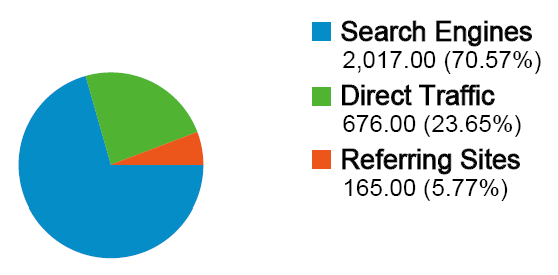
For some, the above numbers may not be too impressive but considering that, not too long ago, the web site had a fourth of the total traffic at best, these numbers are not too shabby. The increase in direct traffic and return visitors has been commensurate with the increase in organic traffic, month after month. I believe this is the ideal with successful SEO work.
How does this happen? It’s all about those
opt-in rates and setting up permission-based
marketing to make your visitors
welcomed and keep them connected.
You see, John focuses on those that are really listening, rather than trying to amplify messages to uninterested parties and generate only lukewarm interest. Together, John and my team have made plenty of big plays in Internet marketing (not just SEO), but we continue to adapt to drive better results.
Let’s look at some of USA-Corporate’s winning strategies in a nutshell:
- Track conversions via your traffic analysis tools (Google Analytics, Clicky, Twitter Counter, Lijit, etc.) to make your progress more measurable.
- Identify your most popular inbound links, then reproduce the methods that worked there for other key content.
- Identify your most popular pages and build off your core content.
- Leverage your top content for prospecting and lead qualification.
- Shorten sign-up/opt-in forms to increase participation and protect privacy.
- Guide leads through specific qualification processes matching their interests and permissions.
- Re-purpose existing content for different platforms and mediums (i.e. newsletters, article syndication, guest blogging, video presentations, webinars, etc.).
- Target search engines and directories that are more prominent in your markets, especially when focusing on international business (Google is not the end-all, cure-all search space but it’s a great place to start).
- Integrate social media to bolster you most compelling content (this is huge but this discussion will be for another time, another place).
The list goes on but the key thing to remember is that Search Engine Optimization sets things in motion, but the strategy attached to your SEO efforts is what really counts. Plugging your visitors into the most compelling content (say, landing pages, free consultation sessions, and freebie info products) is half the battle. The other half is doing the work to build the relationships. Treating SEO in a set-it-and-forget-it manner does little for you.
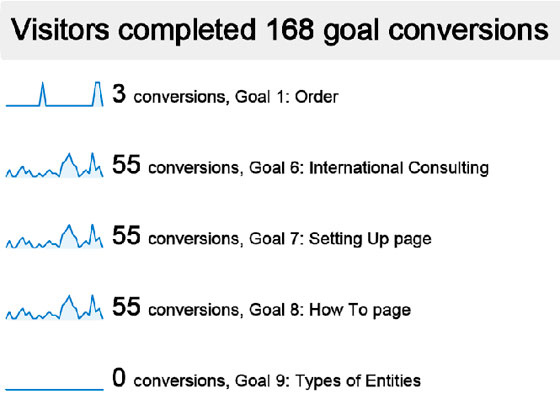
As you can see, we’ve started to build up some goals and plugging them into traffic analysis tools. Since we’ve started tracking conversions via Google Analytics, the numbers have been encouraging. USA Corporate Services, INC. still makes more profit with their offline efforts but their web site is finally becoming a useful networking and prospecting platform. It’s evolving into a community, not just an e-commerce solution or brochure.
Set real goals and get real conversions.
Let’s look at two of USA-Corporate’s landing pages:
- https://www.usa-corporate.com/start-us-company-non-resident/how-to-start-business/
- https://www.usa-corporate.com/start-us-company-non-resident/entity-types/
Question: Which do you think is more successful as-is?
Answer: If you answered B, chances are you value visual appeal and dynamic design over usability and effective web copy. It turns out Landing Page A has lead to greater traffic AND opt-in rates. As we speak, John and company (myself included) are working on tweaking under-performing entry points.
We need to follow USA-Corporate’s lead and continue to adapt and evolve.
The New Rules Of Search Engine Optimization
John Gordon has really put social media to work and he’s only warming up! Facebook is one of the top referral traffic sources but, more importantly, it’s a great place to build those relationships I keep bringing up. By the time John’s followers get to the good stuff, they feel more inclined to really interact and support what he and his team are doing.
We can no longer ignore social media as a powerful pull system (a.k.a. inbound marketing). It brings curious online audiences to your offerings and puts your brand in front of them. Better yet, social media as a whole represents a collective of push AND a pull systems – they attract and reach out to people, sometimes simultaneously! Think of inbound marketing or pull as bringing customers to you (naturally)…
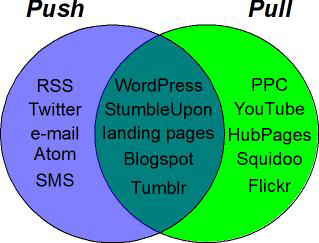
SIDEBAR: Apparently, some other smart cookies have similar thoughts about inbound marketing and how new media changes the business game. Check it out if you want more ideas on how to boost conversions for your business.
The challenge thus becomes spending your time where the people you want to work with are spending THEIR time… OR creating a community compelling enough to have your very own captive audience. Good SEO will make it easier to have people find your social platform and connect with the people you are hand-picking, filling your sales funnel with avid fans and great referral opportunities.
Redefining Search Engine Optimization
I look at SEO as a way to market what, really, is a powerful way to bring people to your web site and raise brand awareness without the usual grind of direct (e)mail, affiliate marketing, referral networking, local ads, and cold calling. We offer “SEO” to clients because that is what people are familiar with now but, really, we should go beyond what “old school” SEO has taught us.
We can no longer design and optimize online content with search engines and directories at the forefront of our thought. The social web has become more humanized and the Google’s latest moves are proof of that. The urgency to step up your Internet marketing game is here and now.
Now let’s see some of the rules at play…
Mr. Panda Knocked Our SEO House Down… Or DID He?
Some of SEOs are rather bitter about the recent changes to Google Search. I can’t blame them: now we have to change our approach completely to stay competitive. Of course, some are still reluctant to embrace social media, saying stuff like…
“Social media is just busy work.
It has no measurable value or ROI.”
Google would beg to differ.

The Google Panda algorithm updates have been a huge wake-up call for Internet marketers. If you did not get the memo, you can no longer game Google to get your content in front of people. Good content and true social influence now trump link popularity and even click-through rates. This means we have to work harder to inspire our supporters to share, vote, link, and participate in ways that tell Google our content matters.
With Google Panda, there are no shortcuts but the good news is that we small businesses can still differentiate ourselves (and our clients) through authentic, persistent, and consistent activity.
With hundreds of changes slated for Google Search in 2011 alone, SEO will take a little more work than before (okay, maybe that’s an understatement). Of course, for those stuck in old ways, Google Panda seems evil or at least a smidge unfair. In actuality, Panda has leveled the playing field and presents us with many opportunities, even if you’re not tech-savvy.
Good-bye black-hat SEO.
Metrics That Really Matter
If you have at least a basic understanding of SEO, you know that lowering your bounce rate means more people are spending more time on your site. You may also know that focusing on long-tail keywords can help you capture traffic from more competitive search spaces while establishing a niche (or micro-niche) of your own. But…
“Are you aware of your ratio of new visitors versus
returning visitors? What are you doing to get people
to keep coming back?”
In my experiences, most Internet marketers as a whole tend to pursue the lofty goal of reaching massive traffic, perhaps for the purpose of increased ad revenues and/or eventually selling the web site. While that is great for most, it’s not good for those of us looking at conversions, improve audience/customer retention, and perhaps selling directly through our blogs and other web sites.
If we want to create avid fans and increase participation, we need to be able to engage your audience, no matter how big or how small it may be. For young start-ups, this can be intimidating, I know. It feels like there’s plenty of B2B support for pre-launch and well-established companies, but those of us in a formulation or reorganization phase are left in the dark. Thus, finding out what to focus on to get the results we want can be a tough order to fill.
EGADS – where do we even start?
True Engagement Versus Mass Appeal
Now, we can go down many avenues and discuss social proof, information products, the ubiquitous drip approach, and all that good stuff. I am not being dismissive regarding any of those wonderful things but I think what most people miss is the engagement part of modern marketing and new media alike. Quite simply, we get some attention and then we quickly lose it because we don’t spend a little extra time with the right people.
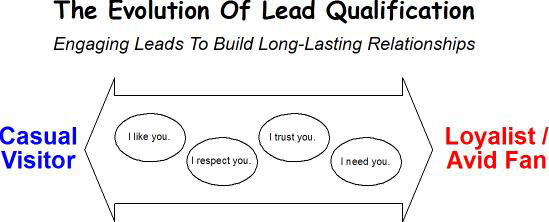
Truly engaging your site visitors and sales leads helps us qualify them further and spend more time with the right people. Qualifying leads tells us if they’ll be better-suited for (but not necessarily limited to)…
- Direct Business
- Partnership
- Trade
- Referral Generation
Recognizing that relationship management is a constant process is crucial. Basic SEO helps bring us pre-qualified leads but it’s our job to continue building rapport. Sure, some of this stuff won’t generate direct sales BUT it’ll help us get there! Did I mention that an active community helps us with a lot of the legwork involved with Internet marketing?
Now, allow me to illustrate how an engaged audience goes to work for you…
Different Strokes For Different Folks
The important thing to remember here is that everyone will experience different results with different techniques, which leads us to this notion of an adaptive SEO approach. Really, that’s just fancy speak for “doing the things that work for you” (and your audience). It’s worth noting that we should throw away the old notion of demographics and placing people in boxes. SEO and Internet marketing as a whole requires some degree of a trial-by-fire.
A truly adaptive SEO approach considers the ever-changing search engine algorithms and competitive online landscape while, most importantly, catering to human audiences. Gone are the days in which you could stuff keywords, buy thousands of links, and just optimize for long-tail search strings to get your page at the top of SERPs.
Nowadays, social signals go a long way. At least, that’s what Google is looking at and everyone else is bound to jump on the bandwagon. If you look at social platforms like StumbleUpon and Squidoo, this has been the direction of search marketing for quite some time.
If all else fails, remember to Do, Analyze, Assess, Rework, and Repeat. Learn the metrics, interact with audiences, then retool your approach accordingly. If you pay enough attention, not only will you find great success, but you’ll be able to replicate it!
Adapt and Convert.
How To Optimize For Search Engines AND Get Converts (Without Being A Cyborg About It)
By now, I hope I created some great urgency for you. It’s important to understand the WHY of our efforts before committing to anything. Now let’s tackle the HOW of adaptive SEO. Here’s the basic operative model:
- Forget what the “experts” say you “must do”, but consider best practices to evolve your current efforts.
- Focus on long-tail keywords to attract specific visitors to the most relevant, compelling content.
- Establish specific processes for different types of leads, focusing on helping people and building relationships (the money will follow).
- Optimize inner pages to capture more of your audience and drive them through the established processes.
- Cross-promote between social platforms to increase the popularity of on-page and off-page content alike.
- Review your traffic analysis to build up your top traffic sources and engage audiences where they originate (i.e. StumbleUpon, Facebook, and Twitter) and on target content (landing pages).
- Tweak your top content to be as direct as possible and drive specific activity – ENGAGE!
- Monitor your direct and indirect competitors across keywords and concentrations, targeting their best practices and top referrers.
- Evaluate your site metrics so that you can focus on the most efficient methods and systems.
- Discover which keywords may have a negative impact, creating confusion or noise for your site visitors.
- Build relationships with your most loyal site visitors and key influencers so they can be converted into avid fans and supporters.
- Continue to engage your audience by giving them opportunities to interact with each other, provide feedback, and get involved.
In your SEO adventures, you’ll find things that work for you and things that don’t. This is where you’ll do things, get stuff done, and adapt your efforts for better, more consistent results. Again, it all starts with specific, measurable goals, but by now we’ve all heard the whole S.M.A.R.T. thing so I won’t go there (at least not right this moment).
There are many tools to get the job done out there but, in the end, just work with the things that you enjoy the most. Mr. Gordon of USA Corporate Services, INC. recommends the following:
I was practicing with an open-source program
called ‘Free Mind’ – it helps you do mind mapping.
What was useful is being able to put down the
thoughts of an arriving visitor. I found that our
pages only partially matched the questions of a
visitor so we only get their partial attention.”
The brilliance in that statement makes me swoon. John Gordon acknowledges the need to meet the need. He goes further by trying to see what people are most interested in and working content around those needs.
It’s so painfully obvious yet we all miss the mark sometimes. Don’t worry: I get over-zealous a bit myself. I understand.
Where Are Your Converts?
With so much content vying for attention out there, creating an avid fan out of a customer or even a casual return visitor can be tough. Now that you have found all these pearls of SEO and social media wisdom…
- How do you (plan to) convert your audience using SEO?
- Where is your core audience now?
- Do you even know who they are right off the bat?
- How dedicated do you think your core audience is?
It’s time to get cracking, my fellows!
